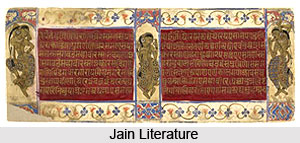Jain literature comprises of two broad categories: canonical and non-canonical. Generally, Jain inscriptions commence with the words Om! Svasti! Sri! Non-Canonical Jain literature involves a large quantity of literary works which contain elements like astronomy, mathematics, grammar, politics and others. Theological works of the Jains have explained the Karma theory and has also thrown light on various philosophical systems. Like Swetambaras, Digambaras have also worked with great enthusiasm in the field of dogmatism and the related disciplines. The numbers of scientific works written on Jain philosophy in modern Indian language are many.
 Canonical Jain Literature
Canonical Jain Literature
It is believed that canonical Jain literature originated from Adinatha, who was the first Tirthankara. Vardhamana Mahavira`s teachings were preserved in twelve different sections called `anga`, while fourteen remaining teachings were recorded in other sections called `purva`. During the 5th century, the Vallabhi Council was appointed to write down the scriptures of canonical Jain literature. The Digambara sects acknowledge that Bhadrabahu was aware of the details of scriptures. The Digambara Jain Literature followed by the Digambara sect freel that there were 25 Agam-sutras (11 Ang-agams and 14 Ang-bahya-agams) that have been compiled from the original preaching of Lord Mahavira, the founder of Jainism. Svetambara canonical Jain literature comprises eleven `anga`, twelve `upanga`, two `sutra`, ten `prakrina`, four `mulasutra` and six `cheda sutra`. Therefore the sacred texts of Svetambaras amount to 84.
Non-Canonical Jain Literature
Jain literature includes many stories involving 63 prominent figures known as `Salakapurusa` and also other people who are related to those figures. `Harivamshapurana` of Jinasena, `Pandavapurana` of Shubhachandra, `Ramachandra-caritrapurana`, `Padma-purana` of Ravisena and other significant literary works are a part of the Jain non canonical literature. Various kinds of stories are present in many of these works which speak about the legendary mythological figure of Rama.
It can be safely concluded that such a unique and huge collection of works in Jain literature bears testimony to the fact that Jains were active in numerous arenas and that they have proved their mettle in almost every realm of Indian culture. Numerous writings deal directly or indirectly with the depiction of the eventful fates of the Jain community in the course of the centuries.




















